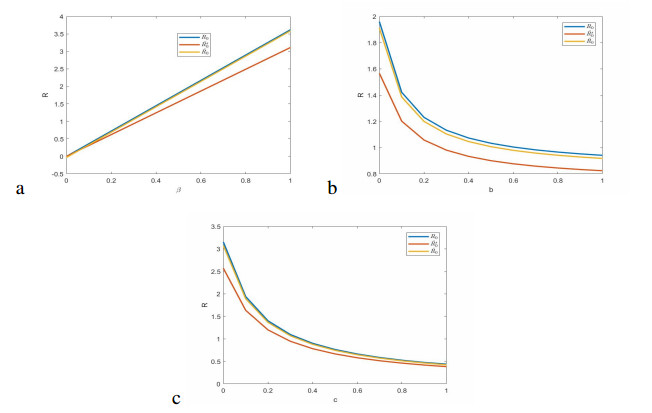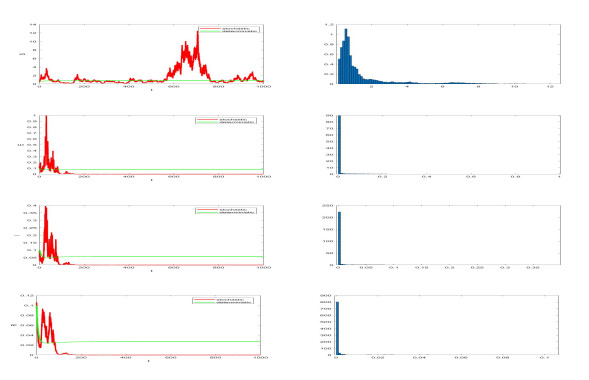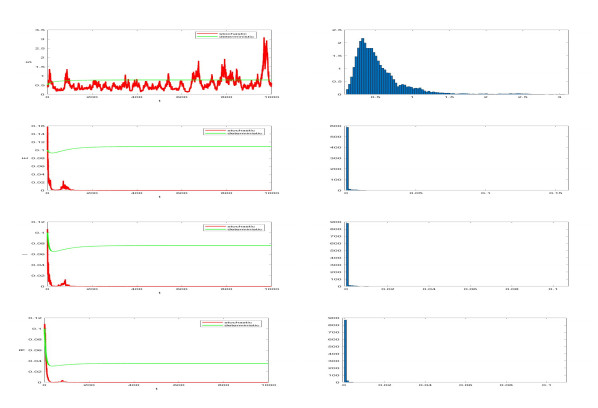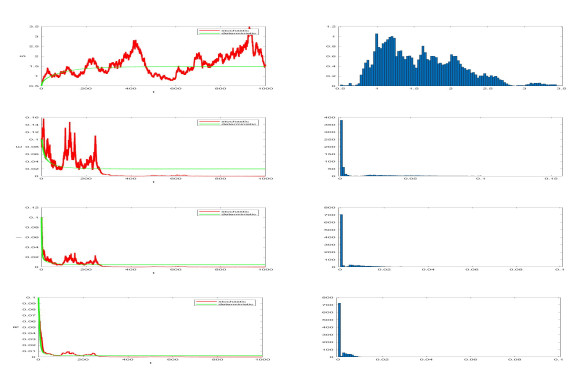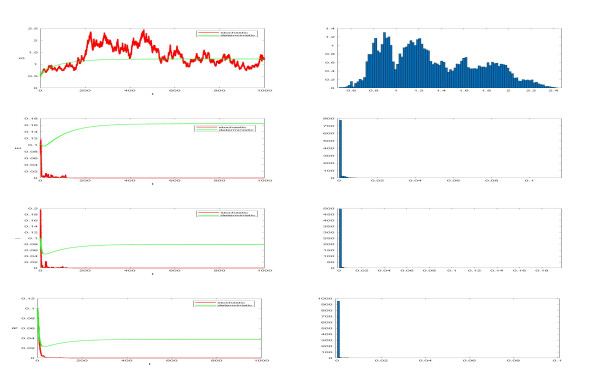1.
Introduction
Influenza, usually known as the flu, is a virus-borne illness that mostly affects the throat, nose and lungs. It can be transferred from person to person by sneezes, contaminated air, or coughing, as well as through direct contact with infected people. Many authors have considered the mathematical models of the influenza virus [1,2,3,4,5]. In real life, there is an exposed time following infection transfer from susceptible to possibly infective person. However, these potentially infective people without any acquired symptoms are capable of spreading the flu. In 2016, Khanh [6] proposed a novel human virus transmission SEIR model with disease resistance. Briefly, the model, reports the recovery of an infected group without any prior therapy. Depending on the treatment, the other groups can be returned to the susceptible group. It describes the susceptible (S), the exposed (E), the infected (I) and the recovered (R) as four unique epidemiological subgroups of persons in the overall population. A set of ordinary differential equations provides the model as
where Λ is the susceptible recruitment rate; α is the susceptibility constant rate for recovered individuals; the contact transmission rates of the virus is denoted by β; the susceptibility rate of individual exposed and infected people is expressed as c and b; γ is the persistent pace of recovery; ϵ is the continuous infectious proportion of the exposed population and μ is the population's natural mortality rate. Positive values are expected for all parameters. In System (1.1), R0=β(γ+b+μ+ϵ)(γ+b+μ)(c+ϵ+μ) represents the basic reproduction number. Importantly, infection persists in the population when R0>1 but finally dies off when R0≤1.
Epidemic models are powerful tools to understand the dynamics of the tramission of an infectious disease. There is a large number of researchers who pay attention to the study of epidemic models. For example, Allegretti et al. [7] derived an SIR model to describe the evolution in time of the infectious disease by Sars-Cov-2; Kumar and Erturk [8] considered a cholera epidemic model from the perspective of generalized Liouville-Caputo fractional derivatives; Özk¨se and Yavuz [9] established a fractional-order pandemic model to discuss interactions between COVID-19 and diabetes by using real data from Türkiye; Naik et al. [10] proposed and analyzed a fractional-order epidemic model with a classic Caputo operator and the Atangana-Balenu-Caputo operator for the transmisson during the COVID-19 epidemic; Yavuz and Özdemir [11] used an SIR model to simulate the transmission dynamics of diseases where individuals acquire permanent immunity. Besides, there are also several works devoted to population systems, such as [12,13,14] and their references.
The population system for the actual world is unavoidably influenced by ambient white noise. The population size may be changed greatly in a short time due to fuctuations in the environment, such as earthquakes and tsunamis. Hence, the parameters of the system may not be absolute constant, and they may fluctuate around some constants. Thus, incorporating environmental noise into the epidemic models seems to be a good way to describe these phenomena. Additionally, in population dynamics, stochastic differential equation model is one of the significant types models because they offer a more realistic description than deterministic models. Biological and epidemiological stochastic models have been examined by many researchers [15,16,17,18,19]. Therefore, in the current research, Imhof and Walcher's technique is followed under the assumption that ambient white noise is a function of S(t), R(t), E(t) and I(t). For sufficiently small Δt, one can model X=(S,E,I,R)T as a Markov process with the following specifications
and
Following is the outline of the model,
where σ2i>0(i=1,2,3,4) signifies the intensity of the white noise. Brownian movements Bi(t)(i=1,2,3,4) are defined on a complete probability space (Ω,F,{Ft}t≥0,P) with a filtration {Ft}t≥0 that meets the standard criteria of mutually independent i.e., while F0 includes all P-null sets, it is increasing and right continuous. Comparatively, the parameters of Systems (1.1) and (1.2) imply the same meaning. And R4+={x=(x1,x2,x3,x4)∈R4;xi>0,i=1,2,3,4} in this paper. We also need to assume that these variables Λ,β,c,b,α,μ,ϵ and γ should be positive constants.
We should ponit out that Ikram et al. [20] considered a stochastic epidemic model consisting of four human classes, i.e., susceptible, infected, vaccinated and removed. They established the global dynamcis of the model in terms of the stochastic basic reproduction number Rs0 and used a stochastic Runge-Kutta method to implement the numerical simulations. In real life, there is an exposed period after the transmission of infection from susceptible to potentially infective members but before these potential infectives develop symptoms and can transmit infection. Due to this reason, the method in [20] cannot be applied to System (1.2). Thus, we need to construct a new auxiliary function to consider this system. On the other hand, a stochastic model may not have the positive equilibrium state. Therefore, we hope to study the existence and stability of "stochastic positive equilibrium" and the existence of a stationary distribution, for this stochastic influenza virus model. As we all know, there are no results about this system. Since the model described by System (1.2) consists of four equations, it is very difficult to construct the Lyapunov function if we consider the existence of an ergodic distribution. Thus, we need to construct a new Lyapunov function and a rectangular set. We also should note that the conditions for extinction of the influenza virus have a close relationship with the basic reproduction ratio R0 in System (1.1).
The structure of the paper is outlined below. In Section 2, we show that there exists a unique global positive solution of System (1.2) with initial value (S0,E0,I0,R0)∈R4+. The existence of ergodic stationary distribution of System (1.2) is established in Section 3. These conclusions can be generated by constructing a suitable stochastic Lyapunov function and a rectangular set. Furthermore, the sufficient condition for the extinction of disease can be found in Section 4. In Section 5, numerical simulations involving Milstein's order method are introduced to illustrate our theoretical results. To wrap up the article, certain conclusions are offered.
2.
Existence and uniqueness of the positive solution
Investigating an epidemic model's dynamic behavior begins with determining whether or not the solution is both positive and global. In this section, inspired by the methods presented in [21], we demonstrate that there exsits a solution for System (1.2) that is a unique, global positive one.
Focus on a stochastic differential equation with an initial value of z(0)=z0∈Rl in an l-dimensional, i.e.,
where f∈L1(Rl×R+,Rl) and g∈L1(Rl×R+,Rl×m). Equation (2.1) is connected with a differential operator L, which is defined as follows
Theorem 2.1. There exists a unique solution (I(t),E(t),R(t),S(t)) to System (1.2) for each given initial value (S0,E0,I0,R0)∈R4+, and this solution will persist with a probablity of 1, i.e., the solution will remain in R4+ almost surely (a.s.).
Proof. Because the local Lipschitz condition is met by the coefficients of System (1.2), there exists a unique local solution (S(t),E(t),I(t),R(t)) on t∈[0,τe) for every initial value (S0,E0,I0,R0)∈R4+, while τe is the explosion time. To show that this solution is global, we only need to verify τe=∞ a.s.. To begin, we demonstrate that S(t), E(t), I(t) and R(t) do not explode to infinity in a limited period. Assume that S(0), R(0), E(0) and I(0) all fall inside the interval [1k0,k0] when k≥k0. For each integer value k≥k0, we determine the stopping time to be
We have specified inf∅=∞ throughout this work (as is customary, ∅ signifies an empty set). Clearly, as a result, when k→∞, τk is increasing. Denote τ∞=limk→∞τk a.s. There exist two constants T>0 and ϵ∈(0,1) such that if this assumption is false, P{τ∞≥T}>ϵ. Hence, there exists an integer k1≥k0 satisfying
Let a C2-function V:R4+→R+ be defined by
For any u>0, this function's nonnegativity may be determined by using u−1−lnu≥0. It does not matter what number is in k≥k0 and T>0. Itˆo's formula may be applied to V(S,E,I,R); then
where LV:R4+→R and
Then
where K is a positive constant in this equation. As a result, we can get
Integrating Eq (2.3) from 0 to τk∧T, we apply the mathematical expectation
Thus,
Setting Ωk={τk≤T} for k≥k1 and by virtue of Eq (2.2), we get P(Ωk)≥ϵ. It is worth noting that for each ω∈Ωk, there exists S(τk,ω), I(τk,ω), E(τk,ω) or R(τk,ω) that is equal to either 1k or k. As a result, either k−1−lnk or 1k−1−ln1k=1k−1+lnk is no more than V(S(τk,ω),E(τk,ω),I(τk,ω),R(τk,ω)). As a result, we may acquire
It then follows from Eq (2.4) that
where the indicator function of Ωk, i.e., IΩk, is inconsistent with what we have allowed. Letting k→∞,
Thus, we have a contradiction. Finally, we have τ∞=∞, and S(t),I(t),R(t) and E(t) do not seem to be exploding in a limited period.
3.
Stationary distribution
Eventually, it becomes important to know when an epidemic dynamical system will continue and propagate through a population. Using deterministic models, this issue may be resolved by considering evidence indicating that the model's global attractor or globally asymptotically stable endemic equilibrium exists. On the other hand, System (1.2) may not have an endemic equilibrium. Considering the hypothesis of Khasminskii [22], we demonstrate that the disease is likely to persist in the mean that there is a stationary distribution. We shall go over a theory introduced in [22] on stationary distributions. The following stochastic differential equation in D-dimensional Euclidean space defines X(t) as a Markov homogeneous process in D-dimensional Euclidean space Ed (Ed denotes d-dimensional Euclidean space)
where b∈L1(Rd,Rd) and gr∈L2(Rd,Rd), r=1,2,⋯,k. And, following is the definition of the diffusion matrix,
Lemma 3.1. [22,Chapter 4.3] The Markov process X(t) has a unique ergodic stationary distribution μ if there is a bound open set D⊂Ed that has a regular boundary Γ and the following conditions:
(1) there exists a positive number M s.t. ∑di,j=1ai,j(x)ξiξj≥M‖ξ‖2,x∈D,ξ∈Rd.
(2) for any Ed∖D, there is a nonnegative C2-function V s.t. LV is negative.
Let f be an integrable function that is integrable with respect to the measure μ(⋅); then,
We will give a definition of the parameter ˆRs0,
Theorem 3.2. Consider that ˆRs0>1 and (S0,E0,I0,R0)∈R4+, there exists a unique stationary distribution μ(⋅) for System (1.2) that has the ergodic property.
Proof. It then follows from Theorem 2.1 that there exists a unique global solution (S(t),E(t),I(t),R(t))∈R4+ with the initial value of (S0,E0,I0,R0)∈R4+. We simply need to confirm Conditions (1) and (2) in Lemma 3.1 to prove this theorem. Now, we shall verify the situation given by Condition (1). The diffusion matrix of System (1.2) is provided by
Selecting M=min(S,E,I,R)∈Dk⊂R4+{σ21S2,σ22E2,σ23I2,σ24R2}, we get
where Dk=[k,1k]×[k,1k]×[k,1k]×[k,1k]. Then, Condition (1) of Lemma 3.1 is satisfied.
Create a C2-function Q:R4+→R as follows:
where 0<θ<2μσ21∨σ22∨σ23∨σ24,
Furthermore, selecting M>0 fulfills the following requirement
where
It is simple to verify this
where Uk=(1k,k)×(1k,k)×(1k,k)×(1k,k). Additionally, Q(S,E,I,R) is a continuous function. This means that just a minimum point (S0,E0,I0,R0) which is in the interior of R4+ is essential for Q(S,E,I,R). Thus a nonnegative C2-function V:R4+→R4+ is defined by
If V1(S,E,I,R)= −c1lnS−c2lnE−c3lnI+c4(S+E+I+R)-c5lnS+c6(S+E+I+R), it holds
If V2(S,E,I,R)=−lnS−lnE−lnI−lnR, it holds that
If V3(S,E,I,R)=S+E+I+R, it holds that
If V4(S,E,I,R)=1θ+1(S+E+I+R)θ+1, it holds that
where
Hence, we have
Now, we will prove the Condition (2) holds. Set
Let
To make it easier, we've divided R4+∖D into eight domains
where ϵi(i=1,2,3,4) are sufficiently small positive constant factors that fulfill the following conditions:
Then, we show that ∀(S,E,I,R)∈R4+∖D, LV(S,E,I,R)≤−1, which is comparable to demonstrating it on the above eight domains.
Case 1. If (S,E,I,R)∈D1, then one has
From Eq (3.3),
∀(S,E,I,R)∈D1andLV(S,E,I,R)≤−1.
Case 2. If (S,E,I,R)∈D2, then one has
Based on Eqs (3.4) and (3.5), we have
Case 3. If (S,E,I,R)∈D3, then one has
From Eq (3.6),
LV(S,E,I,R)≤−2(μβϵ1)12+F<−1,∀(S,E,I,R)∈D3.
Case 4. If (S,E,I,R)∈D4, then one has
It then follows from Eq (3.7) that LV(S,E,I,R)≤−γϵ1+F<−1,∀(S,E,I,R)∈D4.
Case 5. If (S,E,I,R)∈D5, then one has
It then follows from Eq (3.8) that LV(S,E,I,R)<−1,∀(S,E,I,R)∈D5.
Case 6. If (S,E,I,R)∈D6, then one has
According to Eq (3.9), LV(S,E,I,R)<−1,∀(S,E,I,R)∈D6.
Case 7. If (S,E,I,R)∈D7, then one has
From Eq (3.11), LV(S,E,I,R)<−1,∀(S,E,I,R)∈D7.
Case 8. If (S,E,I,R)∈D8, then one has
From Eq (3.10), LV(S,E,I,R)<−1,∀(S,E,I,R)∈D8.
As a result, for sufficiently small values ϵi,i=1,2,3,4, we can demonstrate that
And, as a consequence, the Condition (2) of Lemma 3.1 is satisfied. It follows from Lemma 3.1 that System (1.2) has a unique ergodic stationary distribution.
Remark 3.3. Theorem 3.2 states that if ˆRs0=βμ(γ+μ+b+ϵ+σ232)(μ+σ212)(γ+μ+b+σ232)(c+ϵ+μ+σ222)>1, then System (1.2) has a unique ergodic stationary distribution μ(⋅). If we ignore the white noise, the expression ˆRs0 is equal to the threshold for the deterministic autonomous system System (1.1). This demonstrates that the deterministic system's results may be generalized.
4.
Extinction of the disease
We shall focus on the disease extinction in this section. Defining the following notations for ease of use and simplicity in the following analysis, we have
and
where f is an integrable function on [0,∞).
Lemma 4.1. If (S(t),E(t),I(t),R(t)) is the solution of System (1.2) satisfying any initial value(S0,E0,I0,R0)∈R4+, then
The proof is omitted since it is comparable to [24,Lemma 3.1].
Lemma 4.2. [21,Theorem 1.3.4] Denote M={Mt}t≤0 as a real-valued continuous local martingale vanishing at t=0. It holds that
and
Theorem 4.3. Assuming that System (1.2) has the solution (S(t),E(t),I(t),R(t)) with any initial value (S0,E0,I0,R0)∈R4+. If ˆR0<1,the solution (S(t),E(t),I(t),R(t)) of the System (1.2) satisfies
Proof. By System (1.2), we have
where Q(t)=S(t)+E(t)+I(t)+R(t). Integrating both sides of Eq (4.1) from 0 to t and then dividing by t, it follows that
It then follows from Lemma 4.1 that
Let C(t)=γ+b+μ+ϵc+ϵ+μE(t)+I(t). Note that
Using Itˆo's formula, it holds that
Integrating both sides of Eq (4.4) from 0 to t and then dividing by t, we have
Let M(t)=∫t0γ+b+μ+ϵc+ϵ+μE(s)C(s)dB2(s). It is clear that,
According to Lemma 4.2, we have
Similarly, we get
Based on Eqs (4.5)–(4.7), it holds that
Since ˆR0<1, we can get
based on Eq (4.8).
From System (1.2), we conclude that limt→∞R(t)=0 a.s. when limt→∞I(t)=0 a.s. According to Eq (4.2), limt→∞⟨S⟩t=Aμ a.s. This completes the proof.
Remark 4.4. If R0=β(γ+b+μ+ϵ)(c+ϵ+μ)(γ+b+μ)>1 in the determined model, the infection will continue to exist. However, we can come to this conclusion based on the expression of ˆR0 at the beginning of this section which indicates that if the density of the noise is sufficiently large, the disease may die out.
5.
Numerical simulations
Several examples are presented in this section to exemplify the theoretical findings. Our results are presented as a result of using Milstein's higher method suggested in [23]. Consider the following discretization equation
where the intensities of white noise are represented by the time increment Δt>0,σ2i>0(i=1,2,3,4) and Gaussian random variables ϵi,j∼N(0,1)(i=1,2,3,4). We subdivide the time interval into 1000 equidistant time steps. Moreover, (Sj,Ej,Ij,Rj)T is the value of the ith iteration of the discretized equation.
For the parameters and initial values, refer to the data in [6]. We chose β=0.34,c=0.25,b=0.2,ϵ=0.15,α=0.2, γ=0.1,Λ=0.015,μ=0.01, σ21=0.002, σ22=0.02, σ23=0.04 and σ24=0.005. In this example, numerical simulations were used to show the trajectory images and distribution function graphs of E(t) and I(t), as shown in Figure 1. In the figure, one can find that the number of people making up the infectious population fluctuates around a nonzero value, which means that both will persist in the community. According to Theorem 3.2, ˆRs0=1.05785, and there exists a unique stationary distribution of System (1.2) in this circumstance. The results are supported by the results of numerical simulations.
Now, we will examine the influences of the contact transmission rate, susceptibility rate of exposed individuals and infected people.
Let β vary in [0,1] and keep the other parameters as shown in Figure 1. Figure 2(a) shows that R0,ˆRs0 and ˆR0 are increasing functions. If we lower the viral transmission contact rate β to 0.278 and keep the other parameters the same as in Figure 1, we get the following results. In this situation, the simulations using the initial value (S0,E0,I0,R0)=(0.5,0.1,0.1,0.1) show that E(t) and I(t) of the solutions of System (1.2) tend to 0 as t→+∞. This indicates that the disease is no longer present (see Figure 3). In this case, we may compute ˆR0=0.9751143<1. The disease will die out with a probability of 1 based on Theorem 4.3. The results are supported by numerical simulations. We may deduce that the disease will be eradicated if the rate of infection is reduced.
Following that, let b vary in [0,1] and keep the other parameters as shown in Figure 1. Figure 2(b) shows that R0,ˆRs0 and ˆR0 are decreasing functions. We raise the amount of b to 0.55, as well as the other parameters as shown in Figure 1. The simulations with the initial value (S0,E0,I0,R0)=(0.5,0.1,0.1,0.1) show that when t approaches +∞, E(t) and I(t) of solutions of System (1.2) tend to 0. This indicates that the disease is no longer present (see Figure 4). In this case, ˆR0=0.96<1. Hence the disease will die out with a probability of 1 based on Theorem 4.3. The results are supported by the numerical simulations.
Let c vary in [0,1] and keep the other parameters as shown in Figure 1. Figure 2(c) shows that R0,ˆRs0 and ˆR0 are decreasing functions. Then, we increase the value of c to 0.3 and keep the other parameters the same as in Figure 1. In this situation, the simulations using the initial value (S0,E0,I0,R0)=(0.5,0.1,0.1,0.1) show that when t approaches +∞, E(t) and I(t) of the solutions of System (1.2) tend 0 as t→+∞. This indicates that the disease is no longer present (see Figure 5). In this case, ˆR0=0.67<1. According to Theorem 4.3, the disease will die out with a probability of 1. There is a good correlation between the numerical simulations and the results. In conclusion, the disease will die out by enhancing disease resistance.
From Figures 3–5, one can find that the components E(t) and I(t) of the stochastic epidemic model will approach 0 as t→+∞. We should also point out that the components E(t) and I(t) of the deterministic epidemic model will tend toward positive values as t→+∞. This fact shows that white noise is beneficial for disease extinction. On the other hand, Figure 2 shows that, no matter how we change the values of β,b and c, we have R0>ˆR0>ˆRs0. This result also shows that white noise is beneficial for disease extinction.
Consequently, we chose σ22=0.2,σ23=0.3, and the values shown in Figure 1 for the other variables. In this case, we observed that the (S(t),E(t),I(t),R(t)) of System (1.1) tended to (1.2190,0.1693,0.0793,0.0378) as t→+∞, whereas the I(t) of System (1.2) gradually decreased to 0 as t approached ∞ (see Figure 6). Ultimately, it could be concluded that white noise is beneficial for disease extinction.
6.
Conclusions
Briefly, the current study yielded a stochastic influenza virus model with disease resistance. According to mathematical approaches, in reality, the circumstances required for the disease to die out are rough to some extent. In this study, we focused on a stochastic influenza virus model with disease resistance. First, we obtained the existence of one unique global positive solution satisfying the initial value of (S0,E0,I0,R0)∈R4+. Second, we get the existence of a stationary distribution for the positive solutions by using a stochastic Lyapunov function method. Third, we established the sufficient conditions for extinction of the disease. Finally, we conducted some numerical simulations. The results of the numerical simulations indicate that enhancing disease resistance is beneficial for the control of the disease. In addition, a simple example showed that the white noise is beneficial for the extinction of the disease.
Furthermore, there is a parametric region between the extinction conditions and a stationary distribution for positive solution values. As a result, it is only logical to wonder about the dynamics in this region. We shall address these incidents in future works.
Acknowledgments
This work was supported by the Qian Duansheng Distinguished Scholar Support Program of the China University of Political Science and Law (DSJCXZ180403).
Conflict of interest
The authors declare that there is no conflict of interest.
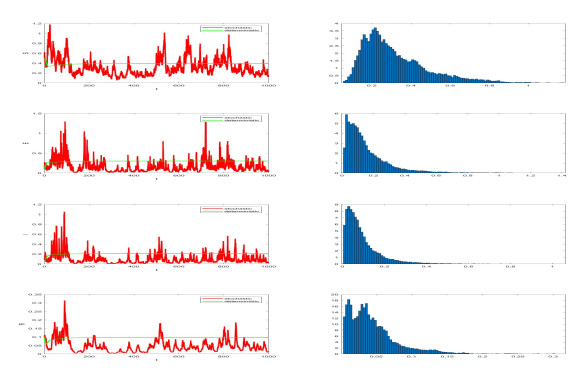









 DownLoad:
DownLoad:
